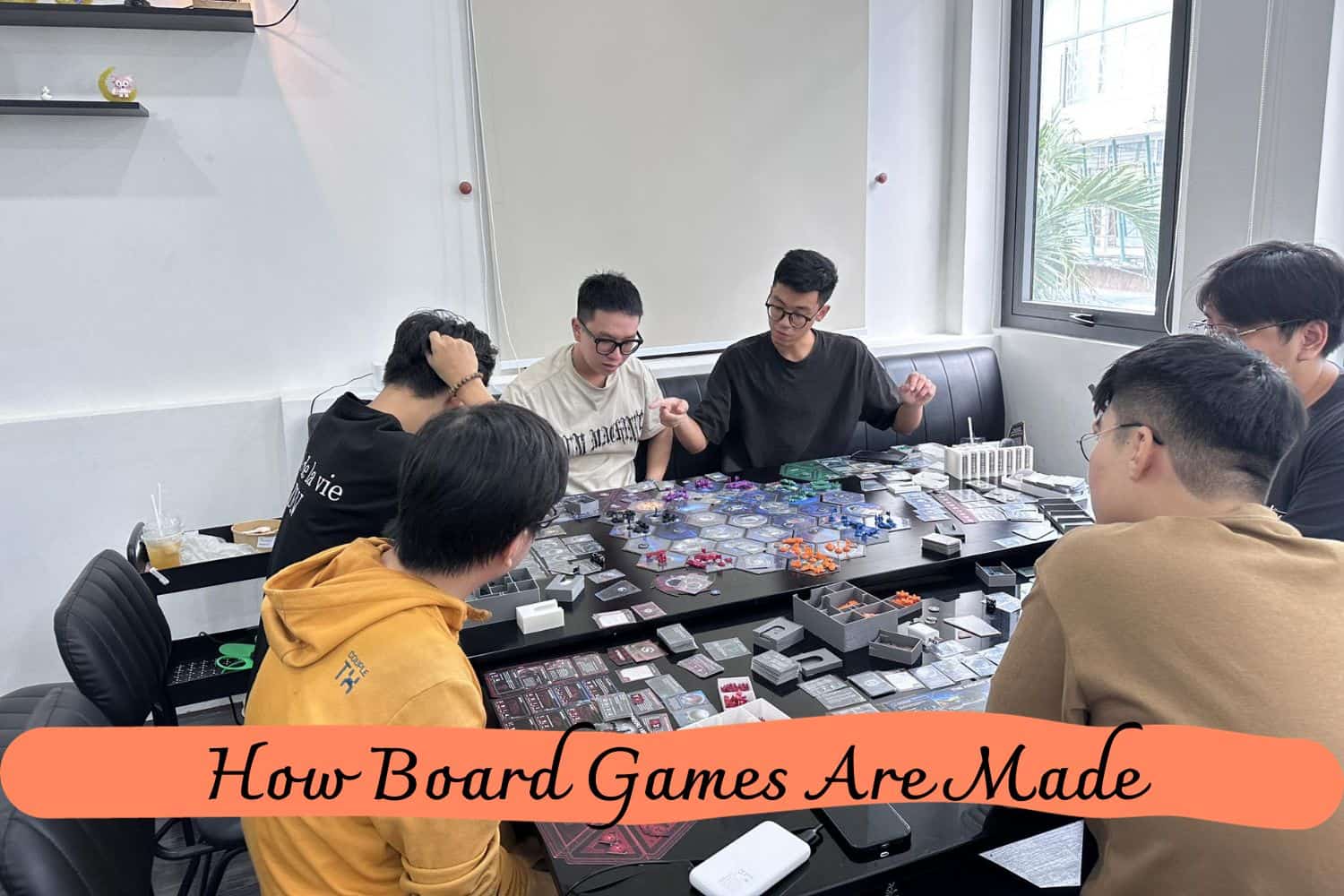Learn the process of designing and manufacturing a board game from scratch. We offer a practical guide on how board games are made, from ideation to production and beyond.
How Board Games Are Made
Do you ever wonder how those intricate board games under the Christmas tree each year are made? Have you ever dreamed up your game and wondered what it would take to see it come alive?
Or perhaps you’re just interested in the process of making a board game from concept to reality. Whatever your reason, we have an exciting peak behind the scenes of board game production for you to explore.
From crafting prototypes ready for playtesting to finding components that perfectly capture its design intent through shipping boxes stuffed with adventure – this journey is full of interesting steps! Read on to find out how board games are made.
Discovering New Ideas for Board Games
Creating a board game often begins with a spark of inspiration – that moment when someone declares, “This would make an amazing board game!” However, turning that initial idea into reality can be a challenge. Surprisingly, most creators start with the end goal in mind and work backward, gradually adding the necessary elements along the way.
From a manufacturing perspective, the various components start to take shape, including:
- Game pieces
- Game board
- Cards
- Dice
- Tokens
- Miniatures
Once the components are outlined, the creator may develop a prototype using simple materials like paper. This prototype incorporates drawings, detailed settings, improvised game pieces, and homemade elements to bring the game to life.
Afterward, the game comes together through a process of trial and error, addition and elimination, and thorough playtesting. Some ideas flourish while others are left behind. This process is true for both board games and card games.
How Board Games Are Made
Embark on an exhilarating journey through the fascinating world of board game manufacturing. From the printing of game components to the final distribution, every step is conducted with precision and detail.
Step 1: Printing
Printing is the foundation of every board game. This involves producing cardboard for the game board, as well as cards, scorecards, and instructions. Our advanced offset machines guarantee top-quality printing. Larger sheets are printed on our 70×100 size machine, while auxiliary GTO machines handle the sets, cards, adhesives, and aids.
Step 2: Component Production
Creating the game pieces is the most time-consuming step. We manufacture various components on-site using different methods depending on the materials and designs. Plastic pieces are made through a process called plastic injection, where melted plastic is injected into a custom mold. Once cooled and solidified, the molding plates separate, and the piece is ready. Complex pieces may require additional assembly and undergo decoration before being placed in the box.
Step 3: Packaging
After all the components are prepared and production is complete, everything is neatly arranged in the package. Our products are carefully placed in boxes, protected with paper, and stacked on pallets, ready to be shipped. We prioritize the durability of our board games, ensuring that all game pieces are securely packaged.
Step 4: Distribution
The final step is getting the board game to its destination. We ship our products in their original boxes to wholesalers, retailers, and online distributors. Whether you prefer shopping online or in-store, our board games are readily available to meet the needs of game enthusiasts everywhere.
Experience the meticulous artistry and precision of board game manufacturing.
The Elements of a Great Board Game
Discovering what makes a board game truly great is a common pursuit among game developers. Regardless of the game genre, there are key elements that are consistently present in popular board games.
A Clear Objective
The utmost importance in any board game lies in the team’s clear understanding of the game’s purpose and ultimate goal. A good game’s objective should be concise, intuitive, and memorable, prominently featured at the start of the rulebook.
Clear and Firm Rules
Despite occasional rule-breaking banter, board game enthusiasts value and expect adherence to the rules. Rules enhance enjoyment and encourage healthy competition. Without them, gameplay can become chaotic and unfulfilling.
Inertia
Nothing is more frustrating than a never-ending game. Games should maintain a steady pace, with engaging milestones to keep players engrossed. Interactions between players should feel meaningful. The goal is to leave players yearning for more even after the game concludes.
Strategy
After a round or two, games solely reliant on luck, like Go Fish, lose their excitement. A truly captivating game involves a higher level of strategy. Players want to feel that their skills improve with each round, encouraging them to return. If victory is determined solely by luck, it is unlikely that players will come back for more.
Conclusion
With the creative elements of art, design, and writing involved in helping create the perfect board game, it’s no wonder why they’ve been popular throughout history.
As exciting as it is to play board games with your friends and family, it can be even more exciting to design them! Don’t feel limited either – you don’t have to worry about being an artist or a writer.
Many aspects of game design can be accomplished with only a little bit of imagination! Take on the challenge and try creating your own unique board game today – see what kind of adventure you can take your fellow players on!
Find inspiration wherever you can and don’t be afraid to take chances. Discover something new with each twist and turn through each roll of the dice.
Who knows what kind of fun adventures await when you delve into the world of game-building?
Thanks for reading our article How Board Games Are Made. If you want to know more information, visit our website here.
Read more:

